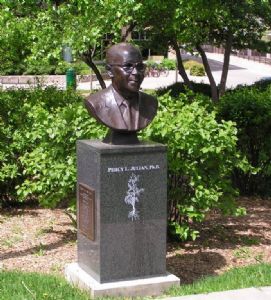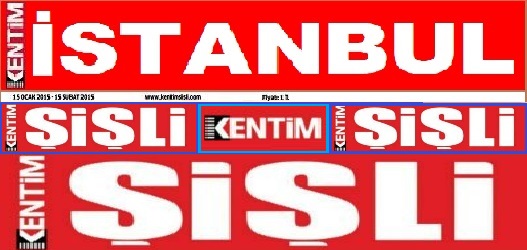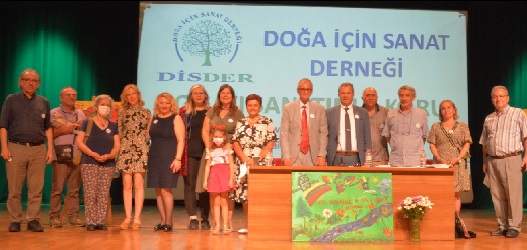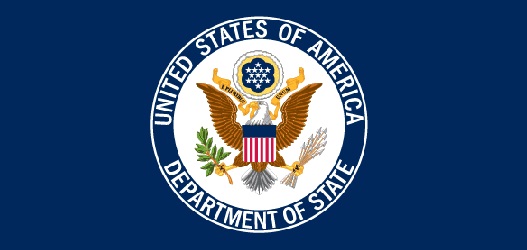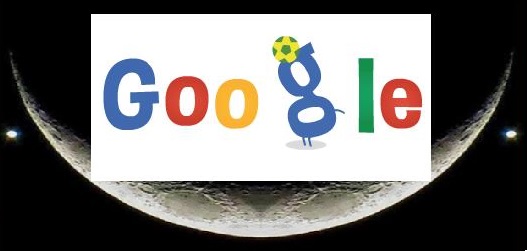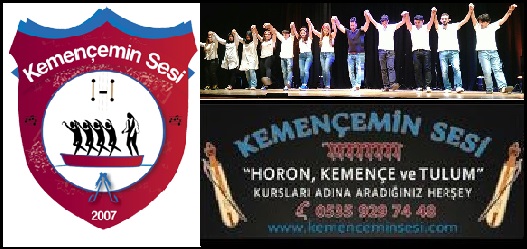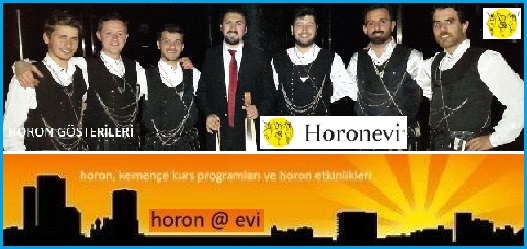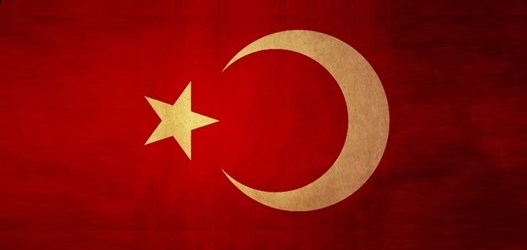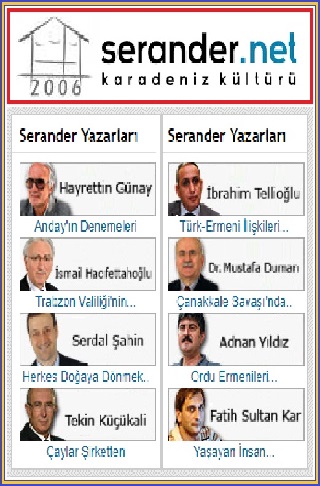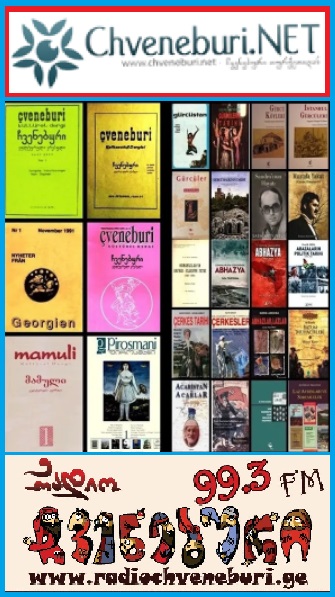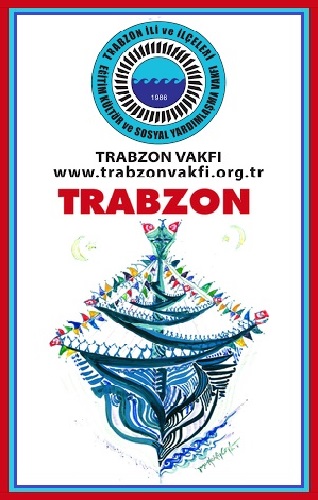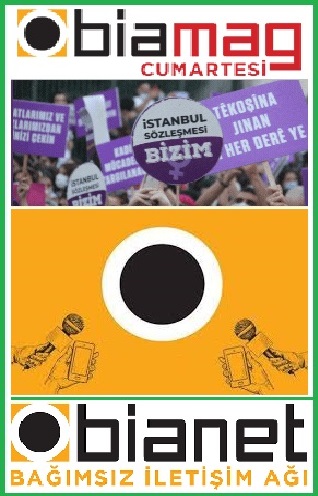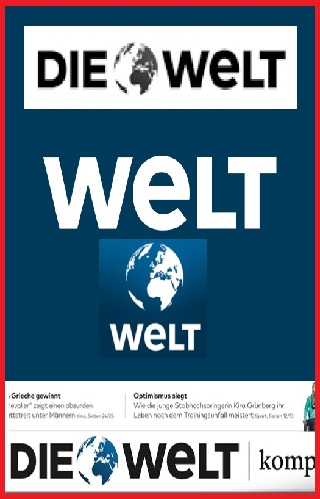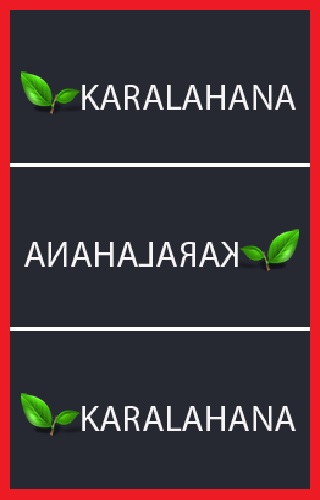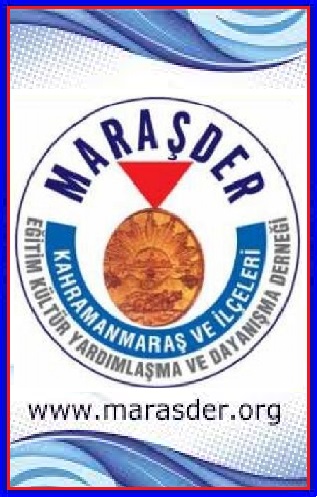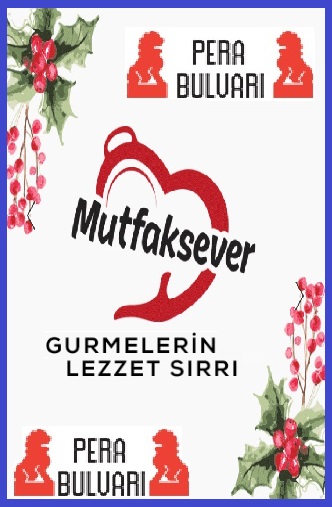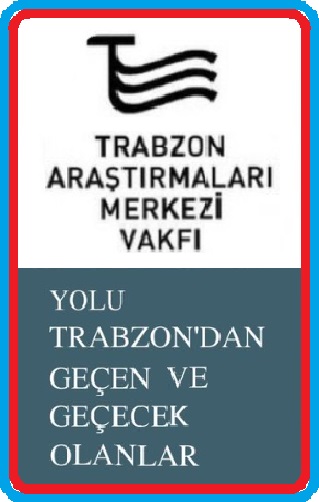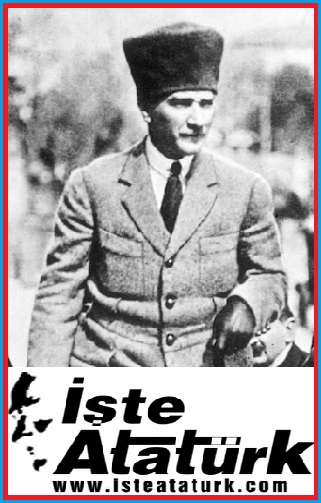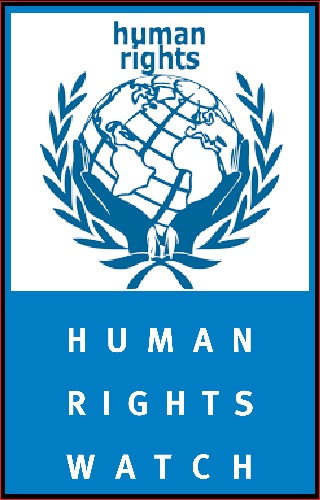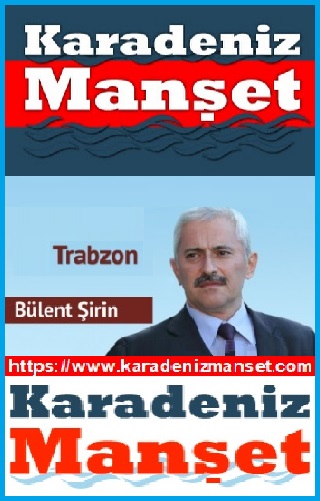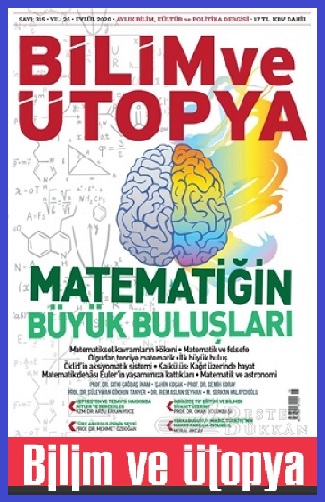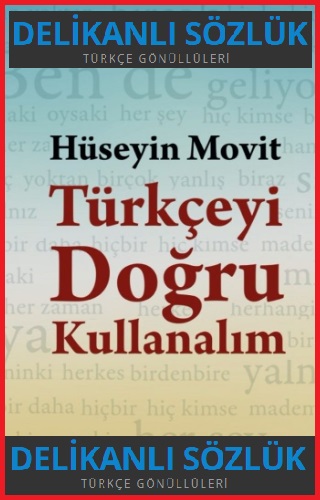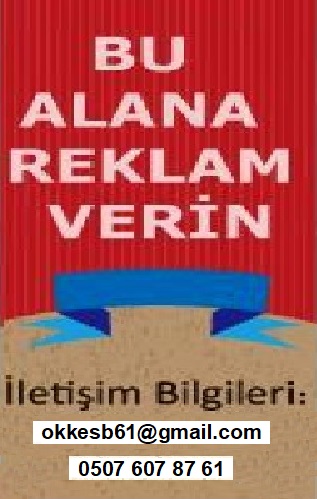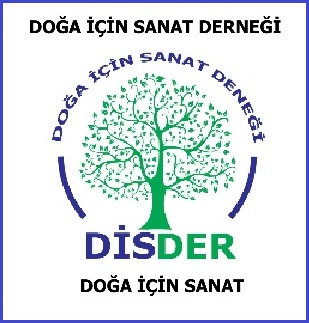Google Doodle
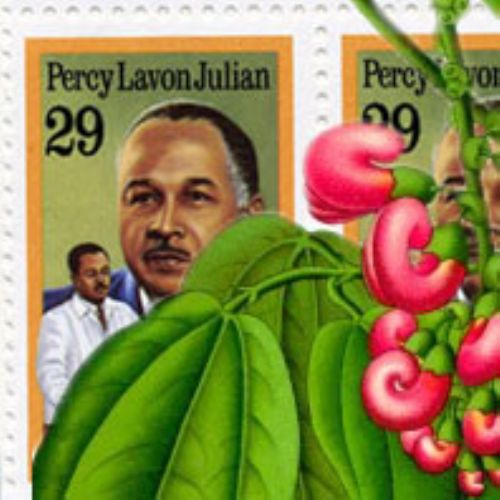
Chemist Percy Julian
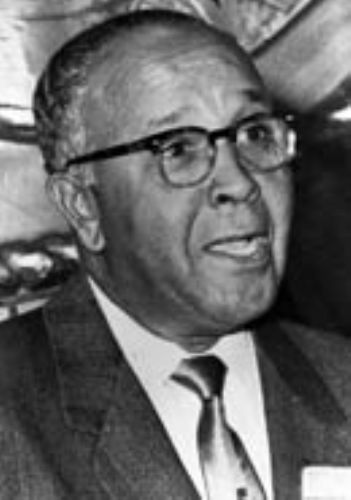 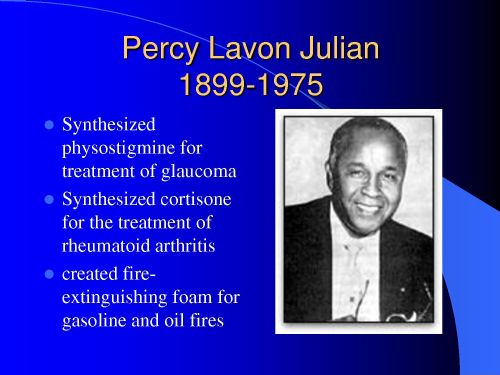
Google Doodle Honors Pioneering Black Chemist Percy Julian Today would have been Julian's 115th birthday
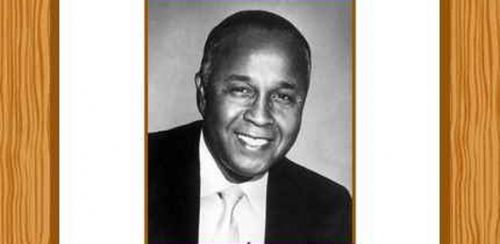
Today’s Google Doodle honors what would have been the 115th birthday of Percy Lavon Julian, a pioneering chemist who overcame the obstacles of segregation to ascend to international notoriety.
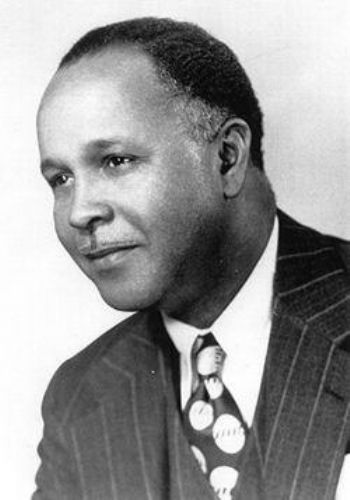 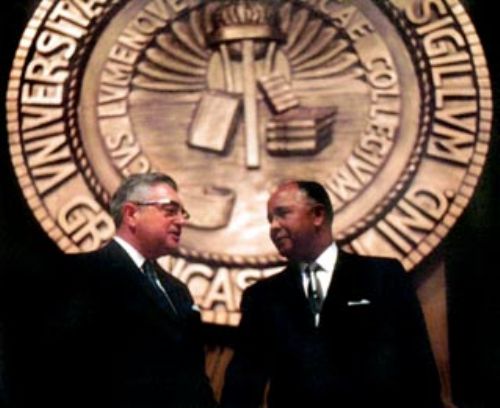
Julian, who died in 1975, was born in Montgomery, Ala. and graduated from DePauw University in Indiana. Julian synthesized chemicals from plants to make medicine, which included treatment for glaucoma and other inflammatory illnesses. He’s most well known for synthesizing male and female hormones from soybean oil and later creating a synthetic substitute for cortisone. His cortisone substitute was inexpensive, yet effective, and helped make the treatment for rheumatoid arthritis more accessible.
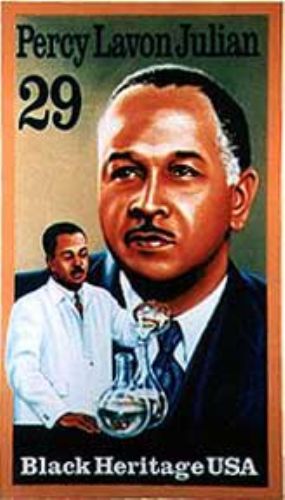 
As an African-American, Julian was denied opportunities to work for large corporations throughout his career, though he went on to hold more 100 patents and received 19 honorary doctorates. In 1990, he was entered into the National Inventors Hall of Fame, and in 1993 he was honored with a Black Heritage Commemorative Stamp by the U.S. Postal service.
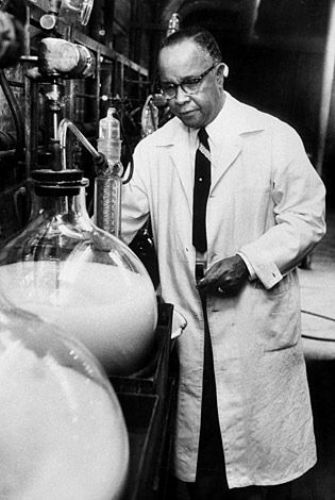 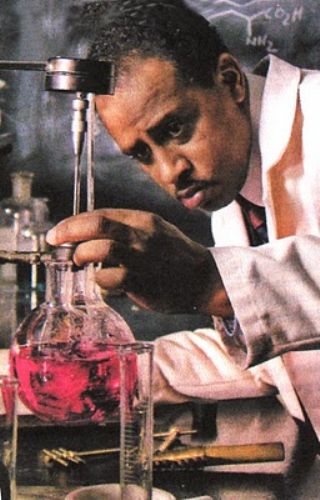
Percy Lavon Julian
Percy Lavon Julian (April 11, 1899 – April 19, 1975) was a U.S. researchchemist and a pioneer in the chemical synthesis of medicinal drugs from plants.
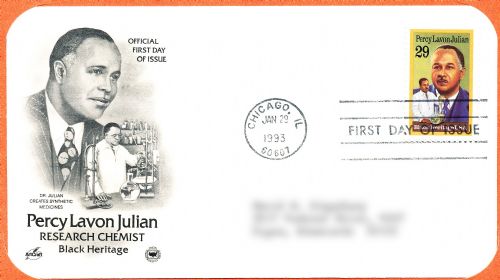
He was the first to synthesize the natural product physostigmine, and a pioneer in the industrial large-scale chemical synthesis of the human hormones progesterone and testosterone from plant sterols such asstigmasterol and sitosterol. His work laid the foundation for the steroid drug industry's production of cortisone, other corticosteroids, and birth control pills.
He later started his own company to synthesize steroid intermediates from the Mexican wild yam. His work helped greatly reduce the cost of steroid intermediates to large multinational pharmaceutical companies, helping to significantly expand the use of several important drugs.
Julian received more than 130 chemical patents. He was one of the firstAfrican-Americans to receive a doctorate in chemistry. He was the first African-American chemist inducted into the National Academy of Sciences, and the second African-American scientist inducted (behind David Blackwell) from any field.
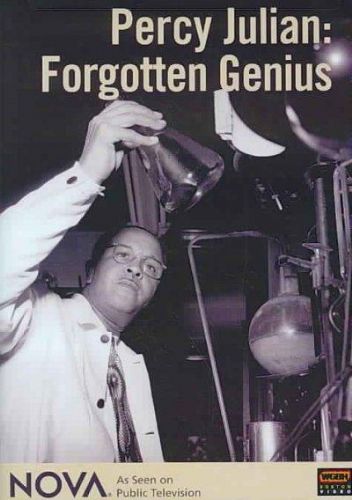 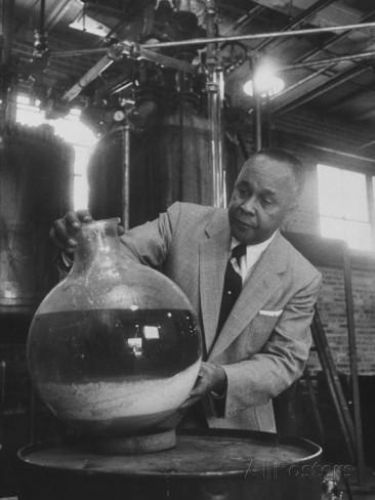
Early life and education
Percy Julian was born in Montgomery, Alabama as the first child of six born to James Sumner Julian and Elizabeth Lena Julian, née Adams. Both of his parents were graduates of what was to be Alabama State University. His father, James, whose own father had been a slave, was employed as a clerk in the Railway Service of the United States Post Office, while his mother, Elizabeth, worked as a schoolteacher.
Percy Julian grew up in the time of racist Jim Crow culture and legal regime in the southern United States. Among his childhood memories was finding a lynched man hanged from a tree while walking in the woods near his home. At a time when access to an education beyond the eighth grade was extremely rare for African-Americans, Julian's parents steered all of their children toward higher education.
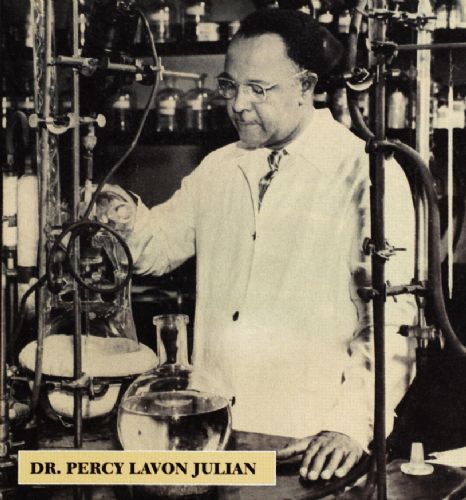 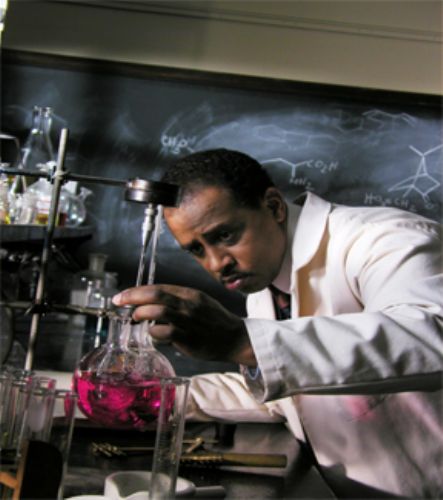
Julian attended DePauw University in Greencastle, Indiana. The college accepted few African-American students. The segregated nature of the town forced social humiliations. Julian was not allowed to live in the college dormitories and first stayed in an off-campus boarding home, which refused to serve him meals. It took him days before Julian found an establishment where he could eat. He later found work firing the furnace, waiting tables, and doing other odd jobs in a fraternity house; in return, he was allowed to sleep in the attic and eat at the house. Julian graduated from DePauw in 1920 Phi Beta Kappa and valedictorian.
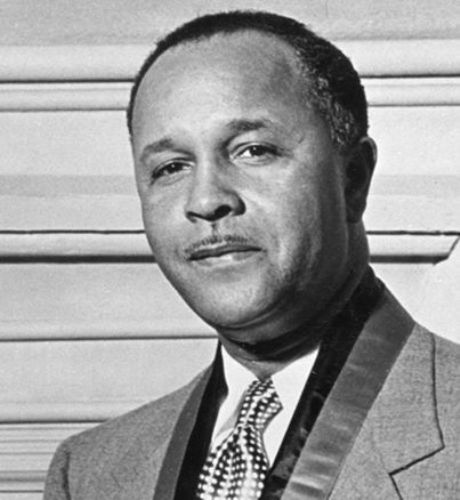 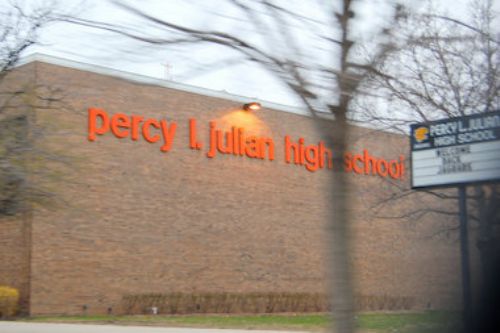
By 1930 Julian's father would move the entire family to Greencastle so that all his children could attend college at DePauw. The father was still working as a railroad postal clerk.
After graduating from DePauw, Julian wanted to obtain his doctorate in chemistry, but learned it would be difficult for an African-American. Instead he obtained a position as a chemistry instructor at Fisk University. In 1923 he received an Austin Fellowship in Chemistry, which allowed him to attend Harvard University to obtain his M.S. However, worried that white American students would resent being taught by an African-American, Harvard withdrew Julian's teaching assistantship, making it impossible for him to complete his Ph.D. at Harvard.
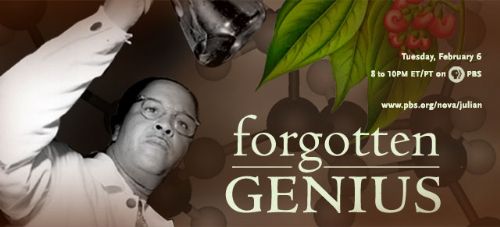 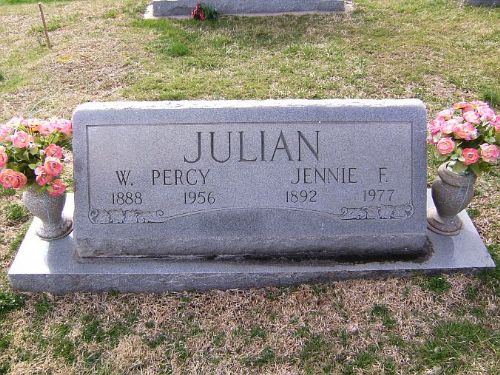
In 1929, while an instructor at Howard University, Julian received a Rockefeller Foundation fellowship to continue his graduate work at the University of Vienna, where he earned his Ph.D. in 1931. He studied under Ernst Späth and was considered an impressive student. In Europe, he found freedom from the racial prejudices that had stifled him in the States. He freely participated in intellectual social gatherings, went to the opera and found greater acceptance among his peers. Julian was one of the first African-Americans to receive a Ph.D. in chemistry, after St. Elmo Brady and Edward M. A. Chandler.
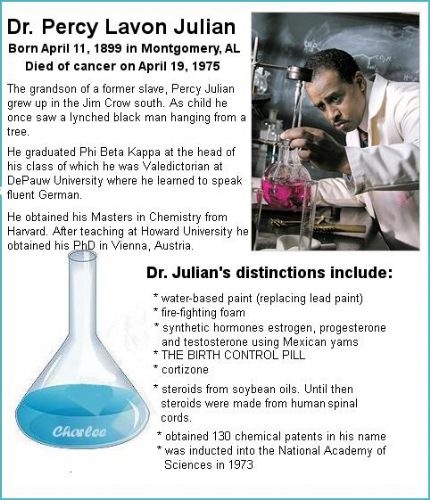 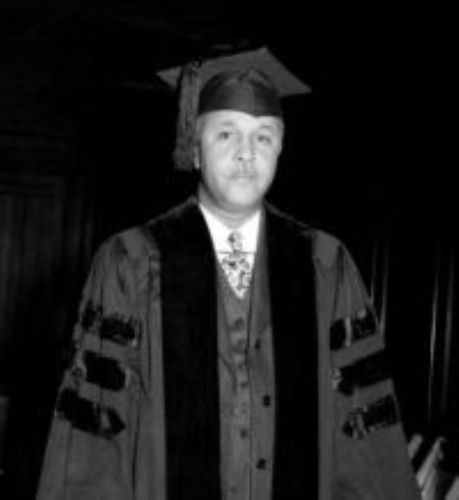
After returning from Vienna, Julian taught for one year at Howard University, where he met his future wife, Anna Roselle Johnson (Ph.D. in Sociology, 1937, University of Pennsylvania). They married on December 24, 1935 and had two children: Percy Lavon Julian, Jr. (August 31, 1940 – February 24, 2008), who became a prestigious civil rights lawyer in Madison, Wisconsin; and Faith Roselle Julian (1944– ), who still resides in their Oak Park home and often makes inspirational speeches about her father and his contributions to science.
At Howard, Julian became involved in university politics, setting off an embarrassing chain of events. At the university president's request, he goaded a white chemist named Jacob Shohan into resigning. Shohan retaliated by releasing to the local African-American newspaper the letters Julian had written to him from Vienna. The letters contained accounts of Julian's sex life and criticism of individual Howard faculty members. Then Julian's laboratory assistant, Robert Thompson, charged he had discovered his wife together with Julian in a sexual tryst. When Thompson was fired for filing a lawsuit against the University, he too gave the paper racy letters which Julian had written to him from Vienna. Through the summer of 1932, the Baltimore Afro-American published all of Julian's letters. Eventually, the scandal and accompanying pressure forced Julian to resign. He lost his position and everything he had worked for.
At the lowest point in Julian's career, his former mentor, William Blanchard, threw him a much-needed lifeline. Blanchard offered Julian a position to teach organic chemistry at DePauw University in 1932. Julian then helped Josef Pikl, a fellow student at the University of Vienna, to come to the United States to work with him at DePauw. In 1935 Julian and Pikl completed the total synthesis of physostigmine and confirmed the structural formula assigned to it. Robert Robinson of Oxford University in the U.K. had been the first to publish a synthesis of physostigmine, but Julian noticed that the melting point of Robinson's end product was wrong, indicating that he had not created it. When Julian completed his synthesis, the melting point matched the correct one for natural physostigmine from the calabar bean.
Julian also extracted stigmasterol, which took its name from Physostigma venenosum, the west African calabar bean that he hoped could serve as raw material for synthesis of human steroidal hormones. At about this time, in 1934, Butenandt and Fernholz, in Germany, had shown that stigmasterol, isolated from soybean oil, could be converted toprogesterone by synthetic organic chemistry.
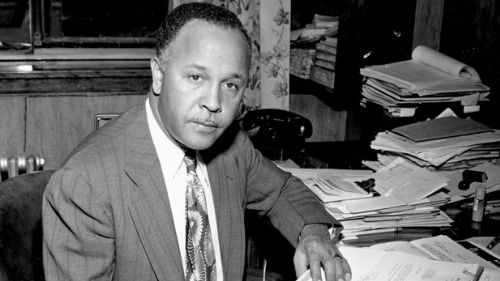
Private sector work: Glidden
In 1936 Julian was denied a professorship at DePauw for racial reasons. DePauw had offered a job to fellow chemist Josef Pikl but declined to hire Julian, despite his superlative qualifications as an organic chemist, apologizing that they were "unaware he was a Negro". Julian next applied for a job at the Institute of Paper Chemistry (IPC) in Wisconsin. However, the Wisconsin city of Appleton, where the institute was located, was a sundown town, forbidding African-Americans from staying overnight, stating directly "No Negro should be bed or boarded overnight in Appleton."
Meanwhile Julian had written to the Glidden Company, a supplier of soybean oil products, to request a five-gallon sample of the oil to use as his starting point for the synthesis of human steroidal sex hormones (in part because his wife was suffering from infertility).
After receiving the request, W.J. O'Brien, a vice-president at Glidden, made a telephone call to Julian, offering him the position of director of research at Glidden's Soya Products Division in Chicago.
He was very likely offered the job by O'Brien because he was fluent in German, and Glidden had just purchased a modern continuous countercurrent solvent extraction plant from Germany for the extraction of vegetable oil from soybeans for paints and other uses.
Julian supervised the assembly of the plant at Glidden when he arrived in 1936. He then designed and supervised construction of the world's first plant for the production of industrial-grade, isolated soy protein from oil-free soybean meal. Isolated soy protein could replace the more expensive milk casein in industrial applications such as coating and sizing of paper, glue for making Douglas fir plywood, and in the manufacture of water-based paints.
At the start of World War II, Glidden sent a sample of Julian's isolated soy protein to National Foam System Inc. (today a unit of Kidde Fire Fighting), which used it to develop Aer-O-Foam, the U.S. Navy's beloved fire-fighting "bean soup." While it was not exactly Julian's brainchild, his meticulous care in the preparation of the soy protein made the fire fighting foam possible. When a hydrolyzate of isolated soy protein was fed into a water stream, the mixture was converted into a foam by means of an aerating nozzle. The soy protein foam was used to smother oil and gasoline fires aboard ships and was particularly useful on aircraft carriers. It saved the lives of thousands of sailors. Citing this achievement, in 1947 the NAACP awarded Julian the Spingarn Medal, its highest honor.
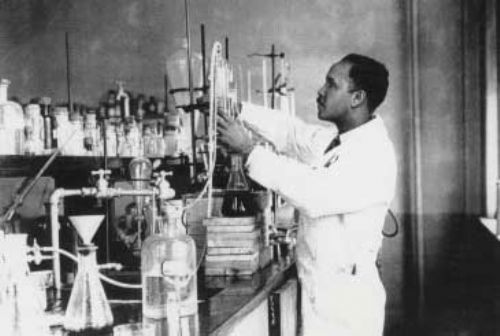
Steroids
Julian's research at Glidden changed direction in 1940 when he began work on synthesizing progesterone, estrogen, andtestosterone from the plant sterols stigmasterol and sitosterol, isolated from soybean oil by a foam technique he invented and patented.[2][3][21] At that time clinicians were discovering many uses for the newly discovered hormones. However, only minute quantities could be extracted from hundreds of pounds of the spinal cords of animals.
In 1940 Julian was able to produce 100 lb of mixed soy sterols daily, which had a value of $10,000 in sex hormones. Julian was soon ozonizing 100 pounds daily of mixed sterol dibromides. The soy stigmasterol was easily converted into commercial quantities of the female hormone progesterone, and the first pound of progesterone he made, valued at $63,500, was shipped to the buyer in an armored car. Production of other sex hormones soon followed.
His work made possible the production of these hormones on a larger industrial scale, with the potential of reducing the cost of treating hormonal deficiencies. Julian and his co-workers obtained patents for Glidden on key processes for the preparation of progesterone and testosterone from soybean plant sterols. Product patents held by a former cartel of European pharmaceutical companies had prevented a significant reduction in wholesale and retail prices for clinical use of these hormones in the 1940s.
On April 13, 1949, rheumatologist Philip Hench at the Mayo Clinic announced the dramatic effectiveness of cortisone in treating rheumatoid arthritis. The cortisone was produced by Merck at great expense using a complex 36-step synthesis developed by chemist Lewis Sarett, starting with deoxycholic acid from cattle bile acids. On September 30, 1949, Julian announced an improvement in the process of producing cortisone. This eliminated the need to use osmium tetroxide, which was a rare and expensive chemical.
By 1950, Glidden could begin producing closely related compounds which might have partial cortisone activity. Julian also announced the synthesis, starting with the cheap and readily available pregnenolone (synthesized from the soybean oil sterol stigmasterol) of the steroid cortexolone (also known as Reichstein's Substance S), a molecule that differed from cortisone by a single missing oxygen atom; and possibly 17α-hydroxyprogesterone and pregnenetriolone, which he hoped might also be effective in treating rheumatoid arthritis, but unfortunately they were not.
On April 5, 1952, biochemist Durey Peterson and microbiologist Herbert Murray at Upjohn published the first report of afermentation process for the microbial 11α-oxygenation of steroids in a single step (by common molds of the orderMucorales). Their fermentation process could produce 11α-hydroxyprogesterone or 11α-hydroxycortisone from progesterone or Compound S, respectively, which could then by further chemical steps be converted to cortisone or 11β-hydroxycortisone (cortisol).
After two years, Glidden abandoned production of cortisone to concentrate on Substance S. Julian developed a multistep process for conversion of pregnenolone, available in abundance from soybean oil sterols, to cortexolone. In 1952, Glidden, which had been producing progesterone and other steroids from soybean oil, shut down its own production and began importing them from Mexico through an arrangement with Diosynth (a small Mexican company founded in 1947 byRussell Marker after leaving Syntex). Glidden's cost of production of cortexolone was relatively high, so Upjohn decided to use progesterone, available in large quantity at low cost from Syntex, to produce cortisone and hydrocortisone.
In 1953, Glidden decided to leave the steroid business, which had been relatively unprofitable over the years despite Julian's innovative work. On December 1, 1953, Julian left Glidden after 18 years, giving up a salary of nearly $50,000 a year (approximately $400,000 in 2014 dollars), to found his own company, Julian Laboratories, Inc., taking over the small, concrete-block building of Suburban Chemical Company in Franklin Park, Illinois.
On December 2, 1953, Pfizer acquired exclusive licenses of Glidden patents for the synthesis of Substance S. Pfizer had developed a fermentation process for microbial 11β-oxygenation of steroids in a single step that could convert Substance S directly to 11β-hydrocortisone (cortisol), with Syntex undertaking large-scale production of cortexolone at very low cost.

Oak Park and Julian Laboratories
In about 1950 Julian moved his family to the Chicago suburb of Oak Park, where the Julians were the first African-American family. Although some residents welcomed them into the community, there was also opposition. Before they even moved in, on Thanksgiving Day, 1950, their home was fire-bombed. Later, after they moved in, the house was attacked with dynamite on June 12, 1951. The attacks galvanized the community, and a community group was formed to support the Julians.
Julian's son later recounted that during these times, he and his father often kept watch over the family's property by sitting in a tree with a shotgun.
In 1953, Julian founded his own research firm, Julian Laboratories, Inc. He brought many of his best chemists, including African-Americans and women, from Glidden to his own company.
Julian won a contract to provide Upjohn with $2 million worth of progesterone. To compete against Syntex, he would have to use the same Mexican yam as his starting material. Julian used his own money and borrowed from friends to build a processing plant in Mexico, but he could not get a permit from the government to harvest the yams. Abraham Zlotnik, a former Jewish University of Vienna classmate whom Julian had helped escape from the Nazi European holocaust, led a search to find a new source of the yam in Guatemala for the company.
In July 1956, Julian and executives of two other American companies trying to enter the Mexican steroid intermediates market appeared before a U.S. Senate subcommittee. They testified that Syntex was using undue influence to monopolize access to the Mexican yam.
The hearings resulted in Syntex signing a consent decree with the U.S. Justice Department. While it did not admit to restraining trade, it promised not to do so in the future. Within five years, large American multinational pharmaceutical companies had acquired all six producers of steroid intermediates in Mexico, four of which had been Mexican-owned.
Syntex reduced the cost of steroid intermediates more than 250-fold over twelve years, from $80 per gram in 1943 to $0.31 per gram in 1955. Competition from Upjohn and General Mills, which had together made very substantial improvements in the production of progesterone from stigmasterol, forced the price of Mexican progesterone to less than $0.15 per gram in 1957. The price continued to fall, bottoming out at $0.08 per gram in 1968.
In 1958, Upjohn purchased 6,900 kg of progesterone from Syntex at $0.135 per gram, 6,201 kg of progesterone fromSearle (who had acquired Pesa) at $0.143 per gram, 5,150 kg of progesterone from Julian Laboratories at $0.14 per gram, and 1,925 kg of progesterone from General Mills (who had acquired Protex) at $0.142 per gram.
Despite continually falling bulk prices of steroid intermediates, an oligopoly of large American multinational pharmaceutical companies kept the wholesale prices of corticosteroid drugs fixed and unchanged into the 1960s. Cortisone was fixed at $5.48 per gram from 1954, hydrocortisone at $7.99 per gram from 1954, and prednisone at $35.80 per gram from 1956. Merck and Roussel Uclaf concentrated on improving the production of corticosteroids from cattle bile acids. In 1960 Roussel produced almost one-third of the world's corticosteroids from bile acids.
Julian Laboratories chemists found a way to quadruple the yield on a product on which they were barely breaking even. Julian reduced their price for the product from $4,000 per kg to $400 per kg. He sold the company in 1961 for $2.3 million. The U.S. and Mexico facilities were purchased by Smith Kline, and Julian's chemical plant in Guatemala was purchased by Upjohn.
In 1964, Julian founded Julian Associates and Julian Research Institute, which he managed for the rest of his life.

National Academy of Sciences
He was elected to the National Academy of Sciences in 1973 in recognition of his scientific achievements. He became the second African-American to be inducted, after David Blackwell.
Death
Julian died of liver cancer on April 19, 1975 in St. Therese Hospital in Waukegan, Illinois and was buried in Elm Lawn Cemetery in Elmhurst, Illinois.
Legacy and honors
In 1950, the Chicago Sun-Times named Percy Julian the Chicagoan of the Year.
Since 1975, the National Organization for the Professional Advancement of Black Chemists and Chemical Engineershas presented the Percy L. Julian Award for Pure and Applied Research in Science and Engineering.
In 1975, Percy L. Julian High School was opened on the south side of Chicago, Illinois as a Chicago public high school.
In 1985, Hawthorne School in Oak Park, Chicago, was renamed Percy Julian Middle School.
In 1980, the science and mathematics building on the DePauw University campus was rededicated as the Percy L. Julian Mathematics and Science Center. In Greencastle, Indiana, where DePauw is located, a street was named after Julian.
Illinois State University, where Julian served on the board of trustees, named a hall after him.
A structure at Coppin State University is named the Percy Julian Science Building.
In 1990, he was inducted into the National Inventors Hall of Fame.[46]
In 1993 Julian was honored on a stamp issued by the United States Postal Service.
In 1999, the American Chemical Society recognized Julian's synthesis of physostigmine as a National Historic Chemical Landmark.[48]
In 2002, scholar Molefi Kete Asante listed Percy Lavon Julian on his list of 100 Greatest African-Americans.
In 2011, the qualifying exam preparation committee at the Albert Einstein College of Medicine was named for Percy Julian.
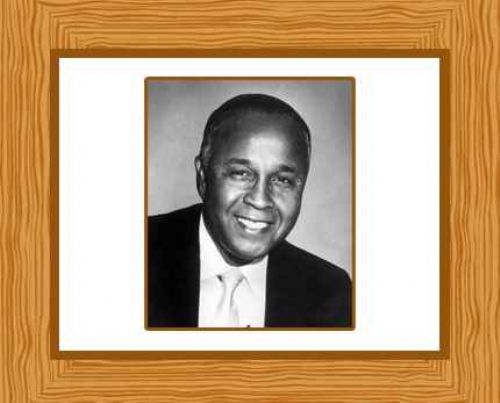
In 2014, Google honored him with a Doodle.
Nova documentary
Ruben Santiago-Hudson portrayed Percy Julian in the Public Broadcasting Service Nova documentary about his life, called Forgotten Genius. It was presented on the PBS network on February 6, 2007, with initial sponsorship by the Camille and Henry Dreyfus Foundation and further funding by the National Endowment for the Humanities. Approximately sixty of Julian's family members, friends, and work associates were interviewed for the docudrama.
Production on the biopic began at DePauw University's Greencastle campus in May 2002 and included video of Julian's bust on display in the atrium of the university's Percy Lavon Julian Science and Mathematics Center. Completion and broadcasting of the documentary program was delayed in order for Nova to commission and publish a matching book on Julian's life.
According to University of Illinois historian James Anderson in the film, "His story is a story of great accomplishment, of heroic efforts and overcoming tremendous odds...a story about who we are and what we stand for and the challenges that have been there and the challenges that are still with us."

Archive
The Percy Lavon Julian family papers are archived at DePauw University.
Patents
U.S. Patent 2,218,971, October 22, 1940, Recovery of sterols
U.S. Patent 2,373,686, July 15, 1942, Phosphatide product and method of making
U.S. Patent 2,752,339, June 26, 1956, Preparation of cortisone
U.S. Patent 3,149,132, September 15, 1964, 16-aminomenthyl-17-alkyltestosterone derivatives
U.S. Patent 3,274,178, September 20, 1966, Method for preparing 16(alpha)-hydroxypregnenes and intermediates obtained therein
U.S. Patent 3,761,469, September 25, 1973, Process for the manufacture of steroid chlorohydrins; with Arnold Lippert Hirsch
Publications[edit]
Studies in the Indole Series. I. The Synthesis of Alpha-Benzylindoles; Percy L. Julian, Josef Pikl; J. Am. Chem. Soc. 1933, 55(5), pp 2105–2110.
Studies in the Indole Series. V. The Complete Synthesis of Physostigmine (Eserine); Percy L. Julian, Josef Pikl; J. Am. Chem. Soc. 1935, 57(4), pp 755–757.

See also
List of African-American inventors and scientists
References, Darlene R. Percy Lavon Julian: Pioneering Chemist (Signature Lives series), Capstone, 2009,
ISBN 0756540895, ISBN 978-0756540890.
^ Jump up to:a b WGBH-PBS. People and Discoveries: Percy Julian, 1899–1975, WGBH-PBS, 1998. Retrieved from PBS.org website.
^ Jump up to:a b c Chemical Heritage Foundation. Restoring And Regulating The Body's Biochemistry: Percy Lavon Julian, Russell Earl Marker, Carl Djerassi, Chemical Heritage Foundation website, 2010.
Jump up^ "Giants of the Past: Percy Lavon Julian (1899–1975) A Forgotten Pioneer in Soy". United States Department of Agriculture. Retrieved February 18, 2012.
^ Jump up to:a b "Lipid Library: Percy Lavon Julian (1899–1975)". American Oil Chemists' Society. Retrieved February 18, 2012.
^ Jump up to:a b c d e f g h i j "NOVA: Forgotten Genius". NOVA (TV series). Retrieved February 13, 2007.
Jump up^ Cobb, W.M. Medical History: Percy Lavon Julian, Ph.D., Sc.D., LL.D., L.H.H.D., 1899– , Journal of the National Medical Association, March 1971; Vol. 63, No. 2, pp. 143–150, PMCID: PMC2609845.
^ Jump up to:a b 1930 US Census; Greencastle, Indiana with Julians; James owned his own home valued at $3,000. Percy Julian's siblings were James Sumner Julian II (1903–?) (Honorary Depauw 1970); Mattie Julian Brown (c 1905–1992) (Depauw 1926); Elizabeth Julian White (c 1907–2007) (Depauw 1928); Irma D. Julian Raybon (1912–1990) (Depauw 1933); and Emerson R. Julian (1917–1978) (Depauw 1938).
^ Jump up to:a b "Milestones". Time. May 5, 1975. Retrieved February 14, 2007. "Died. Percy L. Julian, 76, prolific black research chemist; of Harvard and the University of Vienna on his way to garnering over 130 chemical patents."
Jump up^ Julian family in the 1900 U.S. Census; Montgomery, Alabama; James lived with his wife's siblings: Mather P. Adams (1884–? ); George Adams (1886–? ); Carrie L. Adams (1891–? ); Ethel M. Adams (1893–? ). James is listed as a mail carrier.
^ Jump up to:a b c "Life Chronology". DePauw University. Retrieved February 14, 2007.
Jump up^ "Percy L. Julian Is Awarded Doctorate in Chemistry.".Washington Post. August 2, 1931. "Percy L. Julian, associate professor and acting head of the department of chemistry of Howard University, has been awarded his doctorate in chemistry at the University of Vienna, his achievement being a combination of two years' residence abroad and the transfer of graduate credit from Harvard University."
Jump up^ "Julian Will Do Research in Chemistry in Austrian Universities.". Washington Post. June 9, 1929. "Nine members of the faculty of the college of liberal arts of Howard University have been granted leaves of absence for graduate study during 1929–1930, and one for two years beginning with the fall of 1929. Percy L. Julian will study organic chemistry and microanalysis at the University of Vienna and at Graz University."
Jump up^ "St. Elmo Brady". University of Illinois. Archived fromthe original on September 3, 2006. Retrieved February 14, 2007.
Jump up^ Lamb, Yvonne Shinhoster (March 26, 2008). "Civil Rights Lawyer Percy Julian Jr., 67". The Washington Post. Retrieved November 15, 2009.
Jump up^ A. Butenandt, U. Westphal and H.Cobler, Berichte Deutsche chemische Gesellschaft, Vol. 67, 1934, pp. 1611–1616, 2085–2087.
Jump up^ E. Fernholz. Berichte Deutsche chemische Gesellschaft, Vol. 67, 1934, pp. 2027–2031. (German)
Jump up^ DePauw University. The Life of Percy Lavon Julian '20DePauw University News & Media Office website, February 19, 2009. Retrieved February 22, 2013.
Jump up^ Aer-O-Foam MSDS, S.O.S. Rubber International website.
^ Jump up to:a b "Production: Navy Bean Soup". Time. December 6, 1943. Retrieved May 22, 2010.
Jump up^ U.S. Patent 2,273,046
Jump up^ Bernhard Witkop. "Percy Lavon Julian. 1899–1975." in Biographical Memoirs. National Academy of Sciences, 1980, Vol. 52, pp. 223–266.
Jump up^ "Sex Hormones In Legal Battle". Business Week: 46–50. December 22, 1945.
Jump up^ "Mexican hormones". Fortune 43 (5): 86–90, 161–2, 166, 168. May 1951.
^ Jump up to:a b c d e f g Gereffi, Gary (1983). The pharmaceutical industry and dependency in the Third World. Princeton: Princeton University Press. pp. 53–163. ISBN 0-691-09401-2.
^ Jump up to:a b c Gibbons, Roy (September 30, 1949). "Science gets synthetic key to rare drug; discovery is made in Chicago". Chicago Tribune. p. 1. "Dr. Julian's new method for synthesizing the anti-arthritis compound, cortisone, is less costly than present methods, because it eliminates the need for utilizing osmium tetroxide, a rare and expensive chemical, the Glidden company declared...
But whether has Dr. Julian has also synthesized cortisone from soybeans neither he nor the Glidden company would reveal."
^ Jump up to:a b . (October 10, 1949). "News of the week: New cortisone synthesis". Chemical & Engineering News 27(41): 2936. "Quote: A new synthesis of cortisone, eliminating the need for expensive osmium tetroxide, and the synthesis of three other compounds related to cortisone, which may possible be useful in the treatment of arthritis, have been announced by Percy L. Julian, director of research of the soya products division of the Glidden Co., Chicago. No statement was made as to further details of the new synthesis, but it was revealed that soybean products were not involved... all three [other compounds] were made from soybean sterols."
^ Jump up to:a b Lehman, R.W.; Embree, N.D. (1951). "Soybean oil by-products". In Markley, Klare S. (ed.). Soybeans and soybean products, vol. 2. New York: Interscience Publishers. p. 846. OCLC 1573228. "Cortisone has been synthesized81d from bile acids having unsaturation or oxygenation in ring "C" which can give rise to a keto group at C11. Its synthesis from soybean oil sterols has not been reported, but the preparation from these sterols of closely related compounds which may have partial activity has been announced by Julian.81e"
^ Jump up to:a b c d e f g Applezweig, Norman (1962). Steroid drugs. New York: Blakiston Division, McGraw-Hill. pp. vii–xi, 9–83. "
p. 26:
The pregnenolone experience also served to show that the older hormone producers using cholesterol and stigmasterol could not hope to become suppliers of the vast new quantities of pregnane compounds which the cortical hormones might require. In 1952 the Glidden Co., which until then had been producing progesterone and other steroids from stigmasterol, shifted over to Mexican sources through an arrangement with Diosynth and closed down its own production. The Glidden research director, Percy Julian, and his staff had worked out an excellent synthesis for Compound "S" which started from 16-dehydropregnenolone. The latter compound was directly available from diosgenin but would have been of prohibitive cost if prepared from soya sterols. Since Compound "S" differed from cortisone only by the absence of an oxygen at 11, there were high hopes that Compound "S" would succeed where pregnenolone had failed, as a substitute for cortisone. Compound "S" also proved to be an ineffective precursor when fed to patients with arthritic disease; in fact, it aggravated rather than relieved their symptoms.
p. 30:
The Glidden Company also ventured further afield from its soya sterols to exploit some of the researches of Julian, which were designed to improve the conversion of desoxycholic acid to cortisone. After 2 years, Glidden decided to abandon the production of cortisone from bile acid and to concentrate instead on Compound "S," which now loomed as a competitor for progesterone in processes which could convert it via fermentation to cortisone and hydrocortisone.
Since Glidden's cost of production of Compound "S" was still relatively high, the progesterone group won out, and progesterone [from diosgenin] still remains the raw material of choice at Upjohn."
Jump up^ Witkop, Bernhard. Percy Lavon Julian: April 11, 1899 – April 19, 1975 (Biographical Memoir), National Academy Press, National Academy of Sciences, (undated). Retrieved February 23, 2013.
Jump up^ Peterson, D.H., Murray, H.C. (1952). "Microbiological Oxygenation of Steroids At Carbon11" (PDF). Journal of the American Chemical Society 74 (7): 1871–2.doi:10.1021/ja01127a531.
Jump up^ Shurtleff, William; Aoyagi, Akiko (2004). "History of the Glidden Company's Soya Products / Chemurgy Division". Lafayette, Calif.: SoyInfo Center. Retrieved February 24, 2007.
Jump up^ "Julian leaves Glidden. Will Head Own Firm.".Chicago Tribune. December 2, 1953. pp. C6.
Jump up^ Gowran, Clay (January 6, 1963). "Julian aids mankind with his knowledge". Chicago Tribune. p. 1.
Jump up^ "From Dreams to Determination: The Legacy of Doctors Percy and Anna Julian". Dusable Museum. Retrieved February 13, 2007.
Jump up^ "Arson Fails at Home of Negro Scientist.". New York Times. November 23, 1950. "Chicago, November 22, 1950. Quote: An attempt was made tonight to burn down the expensive home that Dr. Percy Julian, 51 years old, internationally known Negro research chemist, recently purchased in one of the most exclusive sections in suburban Oak Park."
^ Jump up to:a b United States Senate (1957).
Wonder drugs: Hearings Before the Subcommittee on Patents, Trademarks, and Copyrights of the Committee on the Judiciary, U.S. Senate, 84th Congress, 2nd session, pursuant to S. Res. 167, on licensing of United States Government owned patents; removal of obstacles to the production of essential materials from the cheapest source for the manufacture of cortisone and other hormones. July 5 and 6, 1956. Washington: US Government Printing Office. pp. 114–5.
^ Jump up to:a b United States Senate (1960). Administered prices: hearings before the Subcommittee on Antitrust and Monopoly of the Committee on the Judiciary, US Senate, 86th Congress, 1st session, pursuant to S. Res. 57; Part 14: Administered Prices in the Drug Industry (Corticosteroids). December 7, 8, 9, 10, 11, and 12, 1959. Washington: US Government Printing Office. pp. 7884, 8296.
Jump up^ "Inflation calculator". Retrieved February 14, 2007. "Worth $15.6 million in inflation adjusted 2007 dollars"
Jump up^ "DePauw Archives biography". Depauw University. Retrieved February 13, 2007.
Jump up^ "Dr. Percy Julian, Chemist, 76, Dies.". New York Times. April 21, 1975. "Leader in the Fight for Civil Rights Was Synthesizer of Cortisone Drugs. Dr. Percy L. Julian, an internationally known research chemist and a leader in the fight for civil rights, died Saturday in St. Theresa's Hospital, Waukegan, Illinois. He was 76 years old and lived in Oak Park, Illinois."
Jump up^ "Dr. Percy Julian, Chemist, Dies". The Washington Post. April 22, 1975. "Dr. Percy Lavon Julian, 76, an internationally known organic chemist and noted civil rights leader, died Saturday in St. Theresa's Hospital inWaukegan, Illinois."
Jump up^ NOBCChE. NOBCChe Percy L. Julian Award Recipients (not awarded every year), National Organization for the Professional Advancement of Black Chemists and Chemical Engineers (NOBCChE) website.
Jump up^ History of Percy Julian Middle School, Oak Park, Illinois: Oak Park Elementary School District 97.
Jump up^ "Percy L. Julian High School, Chicago". Retrieved February 13, 2007.
Jump up^ National Inventors Hall of Fame
Jump up^ "Black Heritage Stamps". International Information Programs. U.S. Department of State. 2005. Retrieved February 18, 2007.
Jump up^ "Percy L. Julian and the Synthesis of Physostigmine".National Historic Chemical Landmarks. American Chemical Society. Retrieved 2014-02-21.
Jump up^ Asante, Molefi Kete (2002). 100 Greatest African Americans: A Biographical Encyclopedia. Amherst, New York. Prometheus Books. ISBN 1-57392-963-8.
^ Jump up to:a b Taylor, Percy. Percy Julian: Against the Odds,Humanities, published by the National Endowment for the Humanities, January–February 2007, Vol. 28, No. 1.
Jump up^ DePauw University NOVA Back on Campus as Work on Percy Julian Documentary Continues, Depauw University News & Media Office website, June 22, 2004. Retrieved February 22, 2013.
Jump up^ "Percy Lavon Julian (1899–1975) archive". Depauw University. Archived from the original on February 6, 2007. Retrieved February 14, 2007.
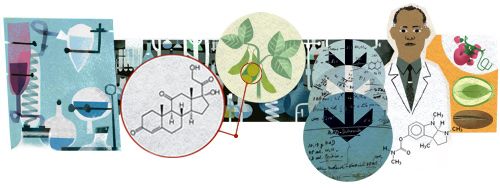
Further reading
Arora, Namit et al. Percy Julian, Chemist Extraordinaire (biography), Shunya's Notes website, June 24, 2007.
Cobb, W.M. (1971). "Percy Lavon Julian, PhD, Sc.D., LL.D., L.H.D., 1899–". Journal of the National Medical Association 63 (2) (March 1971). pp. 143–50. PMC 2609845. PMID 4928023.
Glidden Co. Soy Information Center, Glidden Company.
Cullen, Katherine E. Chemistry: The People Behind the Science (Pioneers In Science), Chapter 8: Percy Julian (1899–1975): Synthesis of Glaucoma Drug and Sterols from Natural Plant Products, Infobase Publishing, 2006, pp. 103–114, ISBN 0816072221, ISBN 978-0816072224.
Kyle, R A; Shampo, M A (1996). "Stamp vignette on medical science. Percy Lavon Julian—industrial chemist". Mayo Clin. Proc. 71 (12) (Dec 1996). p. 1170. PMID 8945489.
Weissmann, Gerald (2005). "Cortisone and the burning cross. The story of Percy Julian". The Pharos of Alpha Omega Alpha-Honor Medical Society. Alpha Omega Alpha 68 (1). pp. 13–6. PMID 15792073.
External links
Percy Julian Chemistry and Civil Rights Resources from Teachers' Domain
The Life and Science of Percy Julian
Bernhard Witkop memoir of Julian
Profile of Percy Julian – The Black Inventor Online Museum
Percy Julian at Find-A-Grave
Percy Julian Archives at DePauw University
PBS Nova documentary and video
Video of a talk by Nova producer Steve Lyons on the creation of the Percy Julian PBS documentary
"Glidden Company History". Glidden Company. Retrieved February 14, 2007.

Ökkeş Bölükbaşı, İstanbul – Nisan.2014 - okkesb@gmail.com,
http://www.medyagunebakis.com/ -okkesb@turkfreezone.com,
https://www.facebook.com/okkes.bolukbasi,
MEDYAJANS – Toplum Dinamikleri Fikir Ajansı
Sosyal, Kültürel, Ticari, Eğitim ve Sanatsal Alanlarda;
Düşünce Üretimi. Paylaşımı. Toplum Yararına kullanımı.!
Bilgi Sahibi Olmadan Fikir Sahibi Olunamaz.! Olunsa olunsa;
Ancak Başkalarının Fikirlerini Tekrarlayan Papağan Olunur.
Ökkeş Bölükbaşı, İstanbul – Nisan.2014 - okkesb@gmail.com, | 



